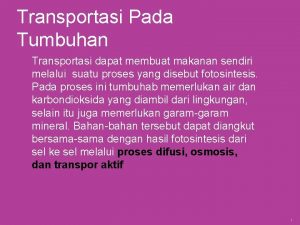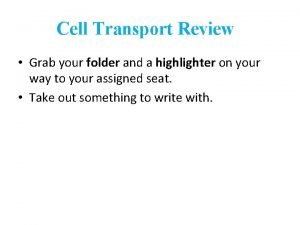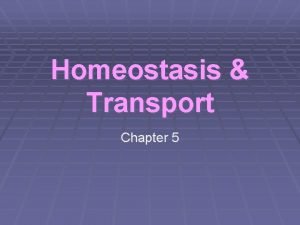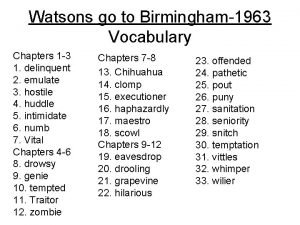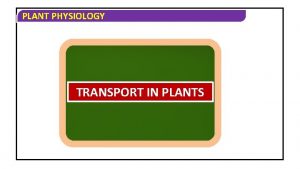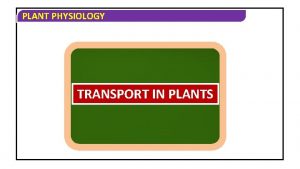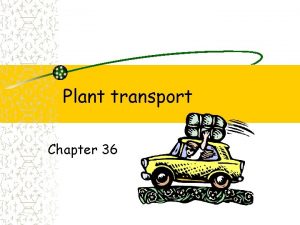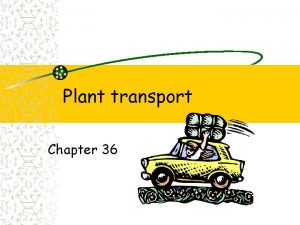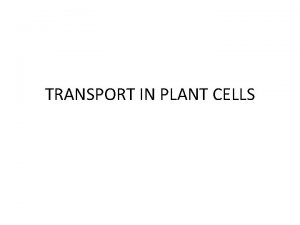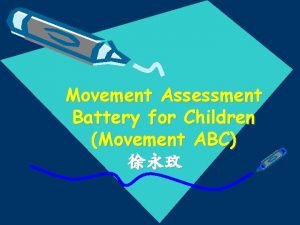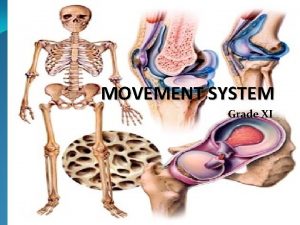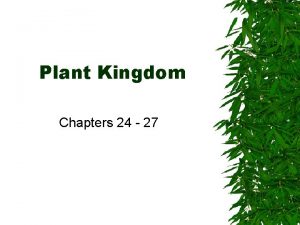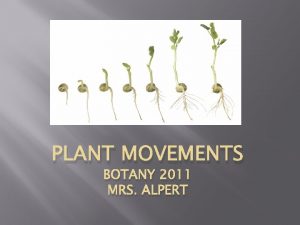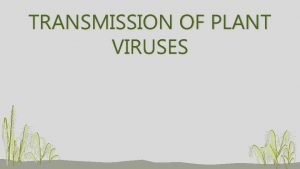Plant Transport Chapters 28 29 REVIEW Transport movement

































- Slides: 33

Plant Transport Chapters 28 & 29

REVIEW • Transport – movement of molecules • Passive transport – down a concentration gradient with out energy – Osmosis – water • Aquaporins – assist water through bilayer – Facilitated Diffusion - large / polar molecules with transport protein – Simple diffusion – small molecules directly through bilayer • Active transport – against a concentration gradient with energy – Endocytocis – engulf large molecules – Exocytosis – remove large molecules – Pumps – ions / large molecules


Proton Pumps • Cotransport • Creates a proton concentration gradient using ATP so other molecules can passively enter the plant cell. – Sugar, NO 3 -


Water Potential and Osmosis • Water Potential = Ψ • Water moves from a higher water potential to a lower water potential • Ψ = Ψs + Ψp • Ψs = solute potential (osmotic potential) – Adding solutes to a solution lowers the solute potential and there fore the overall water potential • Ψp = pressure potential



Osmosis and Plant Cells • Isotonic – external solute concentration the same as the internal solute concentration – Water moves in and out at the same rate – Dynamic Equilibruim – Flaccid or wilty • Hypertonic – external solute concentration greater than the internal solute concentration – Water moves out of cell • Plasmolyszed • Hypotonic – internal solute concentration greater that external solute concentration – Water moves in – Turgid • Healthy plant


Plasmolyzed cell at osmotic equilibrium with its surroundings = 0 s = – 0. 9 0. 4 M sucrose solution: = 0 s = – 0. 9 Initial flaccid cell: = 0 s = – 0. 7 MPa = – 0. 9 MPa (a) Initial conditions: cellular > environmental . The cell loses water and plasmolyzes. After plasmolysis is complete, the water potentials of the cell and its surroundings are the same. Distilled water: = 0 s = 0 MPa Turgid cell at osmotic equilibrium with its surroundings = 0. 7 s = – 0. 7 = 0 MPa (b) Initial conditions: cellular < environmental . There is a net uptake of water by osmosis, causing the cell to become turgid. When this tendency for water to enter is offset by the back pressure of the elastic wall, water potentials are equal for the cell and its surroundings. (The volume change of the cell is exaggerated in this diagram. )

Plant Cell • Cell wall – Plasmodesta (plasmadesmata) • Cytoplasm • Vacuole – Vacuolar membrane is called the tonoplast Cell wall Transport proteins in the plasma membrane regulate traffic of molecules between the cytosol and the cell wall. Cytosol Vacuole Plasmodesma Figure 36. 8 a Plasma membrane Transport proteins in the vacuolar membrane regulate traffic of molecules between the cytosol and the vacuole. Vacuolar membrane (tonoplast) (a) Cell compartments. The cell wall, cytosol, and vacuole are three main compartments of most mature plant cells.


Movement of materials • Symplast – Movement of materials through the cytoplasm of the cell through the plasmodesta – Must cross cell membrane • Apoplast – Movement of material through the cell wall and extracellular spaces – Doesn’t have to cross cell membrane until it reaches the Casparian strip in the endodermis • Bulk Flow – Long distance transport • Xylem or phloem



Roots to Xylem • Root Pressure – pushing of water from the root to the xylem • Water and minerals travel through – The epidermis of the root – The cortex – The stele (inside the endodermis) which contains the tracheary elements • Xylem - tracheids – dead cells


Symplast vs. Apoplast Symplast Path Apoplast Path In cytoplasm (protoplasm) In cell walls Water enters the root cells by crossing the plasma membrane Not blocked by the Casparian strip Can continue to xylem Water does not enter the root cells, but stays in the cell walls Blocked at the endodermis by the Casparian strip Cannot continue to xylem unless it passes into the root cells through the plasma membrane


Key Symplast Apoplast Transmembrane route Apoplast The symplast is the continuum of cytosol connected by plasmodesmata. The apoplast is the continuum of cell walls and extracellular spaces. Symplastic route Apoplastic route (b) Transport routes between cells. At the tissue level, there are three passages: the transmembrane, symplastic, and apoplastic routes. Substances may transfer from one route to another.

Bulk Flow – Water and Minerals • Transpiration – “pulling” of water from the roots to the leaves of plants – Hydrogen Bonding • Cohesion – keeps H 2 O together as it is pulled upward • Adhesion – keeps H 2 O from falling with gravity – Sticks to the sides of the xylem

Transpiration – pg 589 • Chain Reaction – Water evaporates through open stomata – Pulls water from mesophyll cells to the stomata – Plant cells shrink (plasmolysize) due to the loss of water – Tension is created which pulls the water in the xylem up the plant to replace the water in the plasmolysized cells

Xylem sap Outside air Y = – 100. 0 MPa Mesophyll cells Stoma Leaf Y (air spaces) = – 7. 0 MPa Transpiration Atmosphere Leaf Y (cell walls) = – 1. 0 MPa Xylem cells Water potential gradient Trunk xylem Y = – 0. 8 MPa Water molecule Adhesion Cohesion and adhesion in the xylem Cell wall Cohesion, by hydrogen bonding Water molecule Root xylem Y = – 0. 6 MPa Root hair Soil Y = – 0. 3 MPa Soil particle Water uptake from soil Water

Factors that affect transpiration • Heat – increases rate – CAM plants only have stomata on the underside of the leaves to conserve H 2 O • Wind – increases rate • Humidity – decreases rate • # of stomata – increases rate

Transpiration Regulation • Guard cells around the stomata in the epidermis of the plant leaf • CO 2 enters, O 2 leaves and H 2 O evaporates • Light stimulates the stomata to open to allow CO 2 to enter for photosynthesis

20

Xylem vs. Phloem Transport – Bulk Flow Xylem Phloem Dead Cells – Tracheids Living Cells – Sieve Tube Members Water and Minerals Organic Compounds (sugar) Unidirectional Movement (up) Bi-Directional Movement (down, up, side to side) Fast – max rate 15 meters / hr Slow – max flow rate 1 meter / hr NO ATP Transpiration Translocation

Translocation • Photosynthesis occurs in the leaves and produces organic compounds (sugar) for the plant. • These organic substances travel via translocation in the phloem from source to sink – Source – an organ that produces more sugar than it requires (leaf) – Sink – an organ that does not make enough sugar for its own needs (flower, developing bud, root, or fruit)

Source (Leaf) to Sink (Organ of need) • Mesophyll cell produces sugars via photosynthesis • Sugars are transported through bundle sheath cells and companion cells before entering the sieve tube members. • This process occurs via the symplast through the plasmodesta of the cell walls. • Once in the sieve tubes, sugars are transported to the organ of need (sink).

Companion (transfer) cell Mesophyll cell Cell walls (apoplast) Plasma membrane Plasmodesmata Mesophyll cell Bundlesheath cell Phloem parenchyma cell Sieve-tube member

Pressure Flow Model – pg 594 • Sugars are pumped by active transport into companion cells and sieve tube members (phloem). • As sugars (solutes) accumulate, water enters the sieve tube via osmosis from nearby xylem. • Turgor pressure builds in the sieve tube at the source end and the fluid is pushed to the sink organ, which has a lower turgor pressure.

Pressure Flow Model – pg 594 • Sugars are removed using active transport at the sink cells. • Removed sugars are either used (metabolized) or converted into starch for storage. • Left over water in the phloem is pulled into the nearby xylem and transported back up the plant.
 Control tower light signals
Control tower light signals What is the difference between locomotor and axial movement
What is the difference between locomotor and axial movement Intraspecific hybridization
Intraspecific hybridization Taichum
Taichum Plant introduction in plant breeding
Plant introduction in plant breeding Tronsmo plant pathology and plant diseases download
Tronsmo plant pathology and plant diseases download Tronsmo plant pathology and plant diseases download
Tronsmo plant pathology and plant diseases download Albugo eye
Albugo eye Pengangkutan vaskuler adalah
Pengangkutan vaskuler adalah Symport
Symport Primary vs secondary active transport
Primary vs secondary active transport Now answer the following questions
Now answer the following questions Active transport vs passive transport venn diagram
Active transport vs passive transport venn diagram Unlike passive transport active transport requires
Unlike passive transport active transport requires Primary active transport vs secondary active transport
Primary active transport vs secondary active transport Bioflix activity membrane transport active transport
Bioflix activity membrane transport active transport Active transport diagram
Active transport diagram Bioflix activity membrane transport diffusion
Bioflix activity membrane transport diffusion Types of active transport
Types of active transport How do cells maintain homeostasis
How do cells maintain homeostasis Chapter review motion part a vocabulary review answer key
Chapter review motion part a vocabulary review answer key Uncontrollable spending ap gov
Uncontrollable spending ap gov Nader amin-salehi
Nader amin-salehi What is inclusion and exclusion criteria
What is inclusion and exclusion criteria Narrative review vs systematic review
Narrative review vs systematic review The watsons go to birmingham vocabulary chapters 1-3
The watsons go to birmingham vocabulary chapters 1-3 Tuesdays with morrie the classroom
Tuesdays with morrie the classroom Catcher in the rye quotes
Catcher in the rye quotes To kill a mockingbird quiz chapters 1 11
To kill a mockingbird quiz chapters 1 11 To kill a mockingbird chapters 1-6 quiz
To kill a mockingbird chapters 1-6 quiz To kill a mockingbird chapter 9 summary
To kill a mockingbird chapter 9 summary Chapter 4-6 summary to kill a mockingbird
Chapter 4-6 summary to kill a mockingbird To kill a mockingbird chapter 28 summary
To kill a mockingbird chapter 28 summary Chapters 27-31 to kill a mockingbird
Chapters 27-31 to kill a mockingbird








